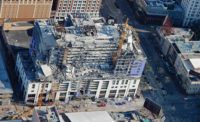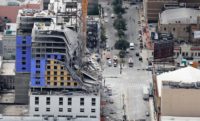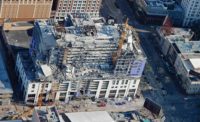Update: the content of this article has been updated on 10/20/19
More than a week after a partial collapse of a hotel under construction killed three construction workers and sent debris tumbling into a New Orleans street, a controlled demolition brought down two tower cranes damaged during the initial collapse. Despite the implosions the upper section of one of the cranes remained lodged on the damaging building as of Oct. 20.
Portions of the upper floors of the under construction Hard Rock Hotel New Orleans collapsed on the morning of Oct. 12. Videos of the collapse showed several of the composite metal deck floor segments pancaking, visibly separating from the structural steel frame of the building. A cause has not yet been officially established, and the precarious structural integrity of the building and surrounding tower cranes has limited investigators' access to the site.
Three construction workers are now confirmed dead: Anthony Magrette, 49, of drywall subcontractor King Cos., Quinnyon Wimberly, 36, of mechanical and plumbing subcontractor Regional Mechanical Services, and Jose Ponce Arreola, 63, of masonry subcontractor Rush Masonry. Approximately 30 people were injured in the collapse, but only one required an extended hospital stay.
With the final deceased worker identified on Oct. 17, the response officially shifted from search-and-rescue to recovery efforts. The damaged building remains structurally unstable.
Bringing Down the Cranes
The two Leibherr tower cranes at the site were brought down in a controlled demolition on the afternoon of Oct. 20 using carefully placed charges that separated the jib and counter-jib from each crane and broke the towers roughly halfway up. The cranes, which stood at 300 ft and 270 ft, fell mostly onto the street, with the upper tower, cab and jib of one of the cranes coming to rest against the top of the damaged Hard Rock hotel structure.
The team of engineers that designed the implosion included consultants from crane owner Morrow Equipment, crane manufacturer Liebherr, as well as demolition contractor Controlled Demolition, Inc.
At a press conference following the demolition on Oct. 20, New Orleans Mayor LaToya Cantrell said "we are safer now than we have been in the past eight days." With the cranes no longer posing a significant threat to the surrounding area, the focus shifts to recovering the remains of two victims still in the partially collapsed building, she added.
"I do not think it could have gone much better," said New Orleans Fire Chief Tim McConnell. "It's way better than it looks."
The plan had been for the debris from the falling cranes to fall entirely within the building site, and according to McConnell they almost succeeded at that. "The front crane went as we expected it to do, the rear crane came down where the building had already partially collapsed." The two 40-ton counterweights from the cranes were severed from their towers during the implosions, and did fall outside the site. "The weights missed the building by a few feet," said McConnell. "[They] hit the sidewalk and the street, and hit a sewer line." While the damage to the sewer line will need to be repaired, there was a relief among officials as the more crucial electric and gas lines running beneath Rampart St. were left unharmed. Minor damage was reported at the historic Saenger Theatre across the street, but the debris from the cranes' implosion appeared to have missed the surrounding buildings.
The upper portion of one of the cranes remains on the partially collapsed building as of the evening of Oct. 20, but McConnell said it can be demolished without further implosions. "It hooked on the building just like we wanted it to," he told reporters. "We'll take another crane and hook to it and cut it in pieces one at a time and get it down. Everything now is inside the construction site, and that was our goal, what we expected it to do."
Mayor Cantrell laid out the next steps for the project, including her call for the complete demolition of the partially collapsed hotel. "The [engineers'] assessment will determine what those next steps will be toward a full demolition," she said. "I don't want anything salvaged on this site, I want a complete demolition."
Planning for an Unexpected Crane Demolition
Getting to a rare double tower crane implosion took a series of unlikely steps. The New Orleans Fire Dept. announced on Oct. 17 that the response team had decided to attempt to bring down the two unstable tower cranes in a controlled demolition. An initial plan to implode the cranes on Oct. 19 was delayed for a day after engineers in lift buckets conducted up-close inspections of the cranes.
Engineers and emergency responders raced against the clock and an approaching tropical storm on Oct. 18 in preparations to demolish the two unstable cranes towering over the collapsed Hard Rock Hotel building — to bring down nearly 145,000 lb of steel, according to officials.
“We’ve developed a close relationship with these engineers, and they understand the gravity and unpredictability of the situation. They’ve called this, even in their realm, unique. To have a building collapse with two damaged cranes, this is a very, very dangerous situation,” New Orleans Homeland Security Director Collin Arnold said at the press briefing on Oct. 18.
McConnell acknowledged that delaying the demolition extended the risk of the cranes collapsing on their own, but that engineers assessed those risks and are working to get the cranes down as quickly as possible. The cranes had shifted several inches since the building collapse with some additional shifting before dawn on Oct. 18.
The formation of Tropical Storm Nestor in the Gulf of Mexico added to the concerns about the precarious cranes and partially collapsed building. City and state officials said the two cranes, along with a single wall that remains standing, posed the three greatest safety risks. “We have concerns about how weather may impact the stability of the cranes,” said Louisiana Gov. John Bel Edwards (D) during a press briefing on Oct. 17.
The initial demolition plan was to place explosives at various points on the crane towers and to cut the crane structures with torches to weaken them. This was expected to cause the cranes to collapse in place, according to officials. “It will be very, very fast, and very minimal,” McConnell said. After visual inspections on Oct. 19 however, he said that the plan had changed. "The cranes are more damaged than they thought," McConnell said during a press briefing on Oct. 19.
Earlier in the week, officials abandoned an earlier plan to use support cranes to dismantle the unstable tower cranes after determining that plan was unsafe. “The largest crane company in America is here and wouldn’t touch it with their cranes. This is how dangerous these are,” McConnell said Thursday.
Lawsuit Filed Over Injuries During Collapse
On Oct. 17, a lawsuit was filed in state court in New Orleans on behalf of ten people injured in the New Orleans Hard Rock building collapse. The suit alleges negligence on the part of several project team companies in both the construction and design of the building.
The suit names the project owners 1031 Canal Development and Kalais Cos., as well as structural engineer Heaslip Engineering, general contractor Citadel Builders and architect Harry Baker Smith Architects II (HBSA II). Brian Trascher, a spokesman for Citadel Builders and the other project team members declined to comment to ENR regarding the lawsuit.
With many of the details of the accident still emerging, the suit is based largely on details that are still being established. “The primary goal is to get to the bottom of exactly what happened, and make sure that nothing like this ever happens again,” said Steve Herman of Herman Herman & Katz and Rene Rocha of Morgan & Morgan, which filed the suit, said in a press statement.
By Jeff Rubenstone, with reporting from Autumn Cafiero Giusti in New Orleans
The text of this article has been updated to reflect new information.






